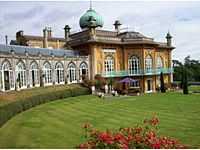Sezincote House
| Sezincote | |
|---|---|
 | |
| General information | |
| Architectural style | Neo-Mughal |
| Town or city | Gloucestershire |
| Country | England |
| Completed | 1805 |
| Client | Charles Cockerell |
| Design and construction | |
| Architect | Samuel Pepys Cockerell |
Sezincote is a British estate, located in Gloucestershire, England. It was designed by Samuel Pepys Cockerell in 1805, and is a notable example of Neo-Mughal architecture, a 19th-century reinterpretation of 16th and 17th-century Mughal architecture from the Mughal Empire.[1]
Sezincote is dominated by its red sandstone colour, typical in Mughal architecture, but features a copper-covered dome instead of the typical white marble. The fenestration is composed of a sequence of extra-large windows with an arch-shape at the top. The arch, however, is not a simple or typical design, but instead a shell-like fan[2] that is evidence of the Mughal influence.
The interior design is more typical European style.
The landscape was designed by Humphry Repton. It is essentially a renaissance-style garden with elements of Hindu style, as seen in the crescent bridge with columns.
Site and commission
The site is located in the country 1.5 miles from Moreton-in-Marsh, "set on high ground in the shelter of the Cotswolds."[1] Col. John Cockerell purchased the estate in 1795 upon his return from Bengal. After his death in 1798, his youngest brother, Charles Cockerell, inherited the property who then "employed another brother, Samuel Pepys Cockerell, to build him a house in the Indian manner."[3]]
Samuel Pepys Cockerell worked as surveyor for the British East India Company and as an apprentice to Sir Robert Taylor, where John Nash was also apprenticed. In spite of his tenure as Surveyor to the East India Company, Cockerell never travelled to India; his encounters with Mughal architecture, a building style that flourished in India in the 16th century, were strictly through the medium of drawings and engravings, such as those by Thomas Daniell (who designed the garden for his "old Indian ally" Sir Charles Cockerell and its temple, bridge, dairy and farm buildings) and his nephews. Cockerell had already experimented cautiously with Indian elements at Daylesford, Gloucestershire, built for Warren Hastings, first governor-general of British India, nearby. Here the style is characterized by a striking revival of Islamic architecture in Northern India, where Persian, Indian, and various provincial styles were fused to produce works of great refinement. Favoured materials included white marble and red sandstone. A notable example is The Taj Mahal, completed in 1648 by the Emperor Shah Jahan.
Architecture
The architectural character of the estate can be described as a British, Georgian era re-interpretation of classic Mughal forms. Emperor Akbar, who ruled the empire from 1556 to 1605, "deliberately mixed Islamic and Hindu elements in architecture in an effort to culturally integrate" his kingdom.[3]
Construction
The house is made of stone, taken from a near-by quarry and may have been artificially stained.[3] Traditional Mughal construction materials would include red sandstone and white marble. Sezincote utilises copper, however, on the dome.
Sources
Oxford Dictionary of National Biography: Thomas Daniell (1749–1840)
References
- ↑ 1.0 1.1 "Sezincote Gloucestershire". Retrieved 5 April 2012.
- ↑ "Sezincote Orangery". Retrieved 5 April 2012.
- ↑ 3.0 3.1 3.2 "Sezincote – House & Garden – The Original Brighton Pavilion – Gloucestershire – Cotswolds". Retrieved 5 April 2012.
External links
- Sezincote official site
- Sezincote entry from The DiCamillo Companion to British & Irish Country Houses
- Official Site of the Cotswolds. Retrieved October 3, 2006.
Coordinates: 51°58′39″N 1°45′04″W / 51.9775°N 1.7512°W